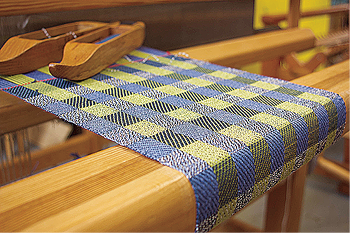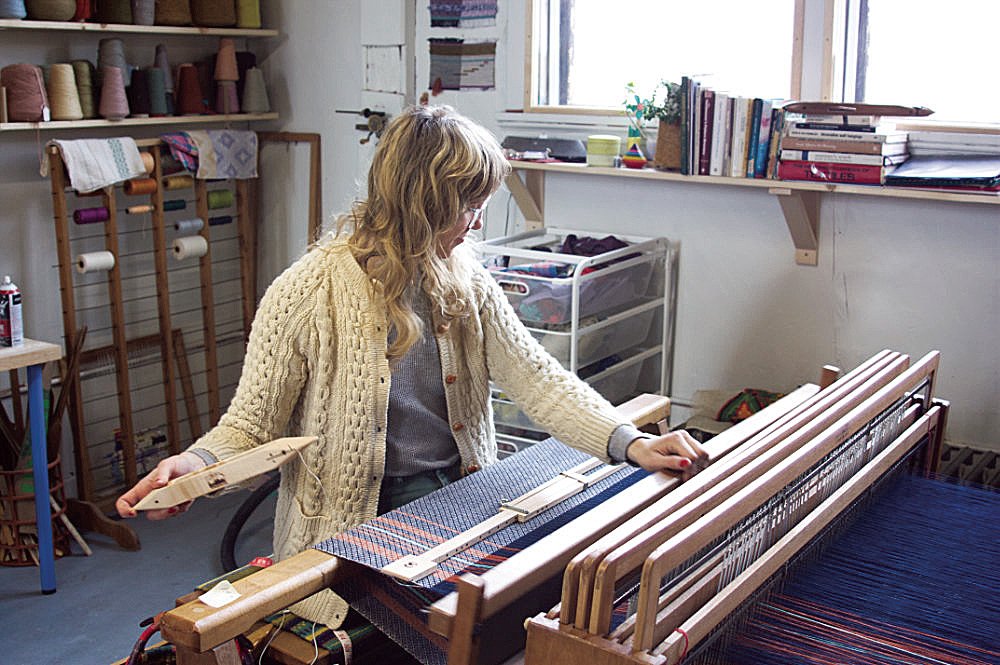The clothes we wear, the towels that dry our hands, the curtains that shield us from excessive sunlight—all these textiles are created with a few methods of production, one of which is weaving. Weaving is among the oldest of cloth production, with the first woven linen pieces dating back to 5000 B.C. Weaving is a simple method where yarn interlaces yarn at right angles to build up a cloth. The two yarns are called warp and weft. The warp runs vertically, organized neatly with consistent spacing. The weft is the yarn used for weaving. The weft thread runs over and under warp threads to build the cloth thread by thread.
I primarily weave on a floor loom, which allows for versatility and efficiency in producing woven textiles. Floor looms are large boxy-looking pieces of machinery meant to store excess warp, keep threads under tension, and provide a mechanized system for lifting warp threads in particular order so the weft can travel through them.
Weaving is really simple binary code—warp thread up, or warp thread down. When the warp threads are lifted, the weft travels under them, and we will see the warp instead of weft on the cloth. When the warp threads are lowered, the weft covers them, and we will see the weft instead. In every pick of weaving, a different combination of warp or weft visibility is created. In that simplicity one can create a myriad of patterns in an endless combination of materials and colors. Most floor looms can make everything from delicate table linens, to hardy woven rugs. It all depends on how the loom is set up, and how the weaver sets the weft into the warp.
I often liken setting up a floor loom to programming a computer. I begin by making several choices—what I’d like to make, what material it will be, the pattern, and the feel of it. Then I set up the loom to effectively weave it. I measure the warp on a warping board, and then chain the long threads and bring them to the loom. From there, I attach the warp to the back of my loom and wind it evenly onto the warp beam. The warp beam stores the excess warp while I’m not weaving on it.

Once the excess is wound, I sit at the front of my loom and thread each individual warp thread through the eye of a heddle. The heddles are metal or cloth pieces suspended on a harness, a large frame that houses groups of heddles. I follow a weaving draft that gives me the sequences to thread each thread. One thread through the first harness, one through the 3rd harness, one through the 2nd harness, on and on until I’ve completed the threading. Next, each warp thread goes through the reed of the beater, which keeps the warp threads spaced out evenly at the width I’m looking for in my woven piece.
Finally, the warp is attached to a rod at the front of the loom, and I tie up the treadles to the harnesses. The treadles are foot pedals that sit below the weaver at the front of the loom. When I push down on a treadle, it can lift a combination of harnesses, which in turn lifts warp threads. Lifting the warp threads creates a shed, or an opening, that I can throw my weft through and begin to weave. By the time the whole floor loom is dressed, before I even begin weaving, I have touched each individual warp thread at least six times. Dressing a loom can take anywhere between three to 15 hours, and that does not include the time it takes to weave.
I choose floor loom weaving because I love the problem solving of creating new patterns and woven objects, the rhythm of the movements, and the fact that I can involve my whole body in the process. Both of my feet are working to press down treadles to lift warp threads. My hands and arms are moving in a steady rhythm as I throw the shuttle across my warp. I also love the endless amount of options available in floor loom weaving and the relative simplicity that the weaver discovers in what seems like an incredibly complex system. I am always thrilled to show people how a floor loom works for the first time. The loom looks so daunting, but once the machine is demystified, you can relate it to the simplest weaving we know. Over under, over under, one thread at a time.
Christine Novotny is a weaver in the Artisan Development program at North House Folk School, where traditional craft is taught on the shore of Lake Superior.

